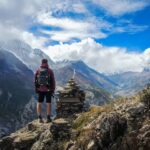Mera Peak, standing at 6,476 meters, is one of the most popular trekking peaks in Nepal. Nestled in the stunning Khumbu region, it offers adventurers a chance to experience high-altitude climbing without the technical challenges of more difficult summits. With its scenic views and rich climbing history, Mera Peak attracts climbers from around the world. Understanding what this trek entails helps clarify its appeal and significance in the climbing community.
Reasons to Consider Mera Peak in 2025
One of the main reasons to consider climbing Mera Peak in 2025 is the breathtaking scenery. The ascent provides panoramic views of some of the highest peaks in the world, including Everest, Lhotse, and Makalu. The varied landscapes—from lush forests to rugged mountain terrain—make every step of the journey visually captivating.
Additionally, Mera Peak is suitable for climbers with various experience levels. While prior mountaineering experience is beneficial, many climbers can attempt this peak with good physical fitness and a willingness to learn. This accessibility makes Mera Peak a great option for those looking to transition from trekking to climbing.
What to Expect During the Climb
When climbing Mera Peak, you can expect a well-defined route that guides you through diverse terrains. The journey typically takes 12 to 18 days, allowing ample time for acclimatization. As you progress, you’ll face challenges such as changing weather conditions and varying altitudes. However, reaching the summit is incredibly rewarding, offering a sense of accomplishment and stunning views that make the effort worthwhile.
It’s important to prepare for both the physical and mental aspects of the climb. The experience is not just about reaching the top; it’s also about enjoying the journey, the camaraderie with fellow climbers, and the beauty of the Himalayan landscape.
Planning Your Climb
Effective planning is essential for a successful Mera Peak climb. The best seasons for this adventure are spring (March to May) and autumn (September to November). During these months, the weather is generally stable, allowing for clearer skies and better climbing conditions.
Additionally, securing the necessary permits is crucial. Climbers need a climbing permit for Mera Peak, as well as a Trekkers’ Information Management System (TIMS) card. Taking care of these details ahead of time can ease the logistical aspects of your climb.
Preparing for the Climb
Preparation goes beyond just logistics; it also involves having the right gear. Essential items include a good quality sleeping bag, warm clothing, climbing harness, and trekking poles. A well-thought-out packing list can make a significant difference in your comfort during the climb.
Moreover, physical training is key to enjoying the experience. Engaging in regular cardiovascular and strength training exercises can help build the stamina needed for high-altitude climbing. Activities such as hiking, running, and strength training are effective ways to prepare your body for the demands of the climb.
Alternatives to Mera Peak
While Mera Peak offers a unique climbing experience, it is also beneficial to consider alternatives in the region. Peaks like Island Peak and Lobuche Peak provide different challenges and experiences. Comparing these options can help you determine which peak aligns best with your climbing goals and experience level.
Mera Peak, however, stands out for its combination of accessibility and stunning views, making it a compelling choice for many climbers.
Conclusion
In conclusion, climbing Mera Peak in 2025 presents an exciting opportunity for those seeking adventure in the Himalayas. With its beautiful landscapes, moderate climbing requirements, and rewarding experiences, it appeals to both novice and experienced climbers. By carefully planning your ascent and adequately preparing, you can fully embrace the journey. If you are looking for a memorable high-altitude adventure, Mera Peak may just be the right choice for you.






